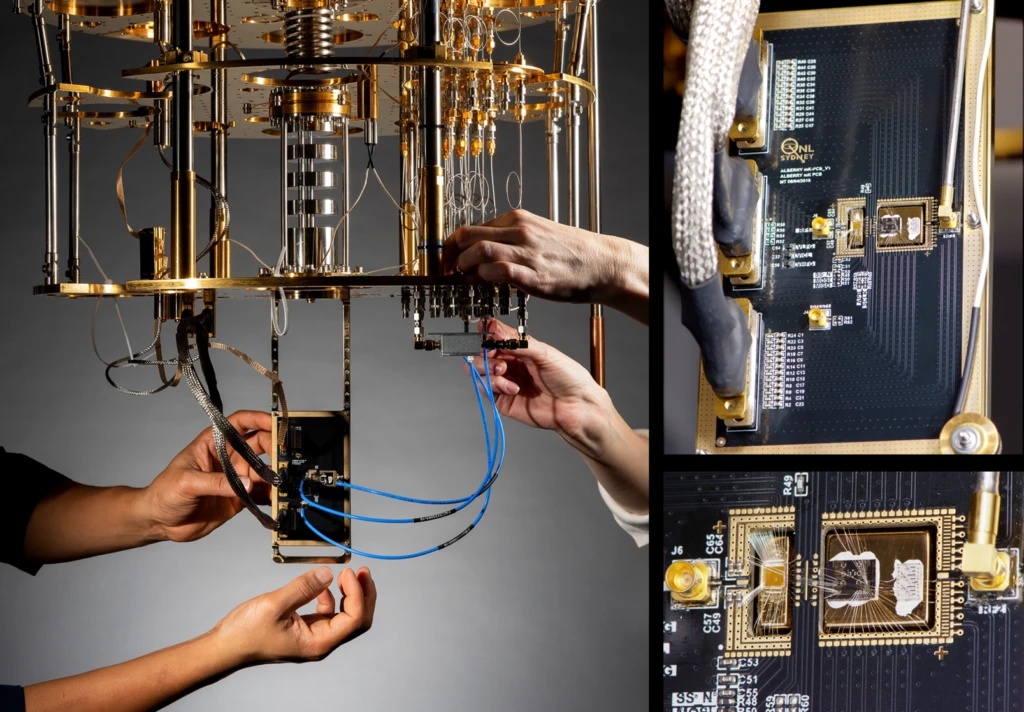Quantum Computing (QC) is an emerging technology promising a paradigm shift in computing. Leveraging quantum mechanics, this powerful technology can provide solutions to problems that currently require large supercomputers or are just unsolvable with the present classical computers - even with the most advanced computing hardware. Quantum computing is without a doubt a topic business and tech leaders should keep an eye on as it has potential to be the most disruptive technology in computing to date. While true Quantum supremacy is not here yet, Quantum as a Service (QaaS) cloud offerings like Azure Quantum are available now and already provide great ROI.
This blog post provides an introduction to the technology, outlines what is currently possible, and highlights use cases where our Reply network is already helping clients create significant business value with QC-inspired solutions.

Figure 1: Cryo-CMOS Technology. Image on left courtesy of The University of Sydney, Louise M. Cooper.
What is Quantum Computing?
A Quantum Computer’s computational functionality is based on the laws of quantum mechanics, the scientific laws of physics that describe the smallest dimension of our nature: molecules, atoms and subatomic particles like electrons, photons etc. At this small level new physical phenomena like superposition and entanglement can be observed and these are used when computing with Qubits. Quantum bits are the basis of Quantum Computing and can – in contrast to classic computing bits, which can only represent either state zero or one – be in state zero, one or both at the same time (superposition state).

Figure 2: Classic bit that can only be 0 or 1 VS Qubit that can be in superposition anywhere on the sphere (Source: https://dlpng.com/png/7156627)
Leveraging the Qubits superposition of multiple states at the same time and applying QC operations, Quantum Computers can in principle run complex computations at unseen fast processing time. Though at the center of debate, one application claims that through QC one could solve calculations that would take 10,000 years on a classical supercomputer, in just 200 seconds.
Where is QC already providing value?
Quantum computing is a hot research topic and we will see more hardware and software breakthroughs in the 2020s with universities and big tech players chasing for the next generation of computing as classic computers reach the end of what’s physically possible.
Quantum Machine Learning (QML), Quantum Optimization and Quantum Security are gaining a lot of momentum together with Quantum-Inspired Computing (QIC). Even in the infancy of the QC hardware, Quantum-Inspired Computing, which is running QC-inspired algorithms on classical computer hardware, is already providing significant business value and is outpacing classical state-of-the-art solutions in many areas. In particular we are seeing large gains with Quantum-Inspired Optimization (QIO) and solver algorithms for models such as Quadratic Unconstrained Binary Optimization (QUBO) which allow one to formulate a combinatorial optimization problem so that it can also be solved by quantum computers.
Optimization problems can often be described as (non-linear) cost saving, fitness, or energy minimization functions, called objective functions, with multidimensional parameters and subject to several (non-linear) constraints. The goal is to find the optimal parameter configuration that allows one to obtain the global minimum of the objective function.
We experience these cost saving functions in our everyday life solving complex problems like public transport scheduling, workforce management, vehicle routing, financial investment optimization, fleet management, ship/plane/truck loading and workload optimization, pharmaceutical, fertilizer and other chemical processing and many more.

Figure 3: Optimization as simplified energy minimization problem with Quantum Annealing (tunneling) and thermal annealing (jump) to solve the local minimum problem. (Source: http://bit.ly/QiCAnnealing)
The challenge in solving these optimization problems is to find the global minimum and not get stuck in the local minima. This is where QC comes into play, taking advantage of quantum mechanical effects such as exploration and exploitation of the solution space via Quantum Annealing. Quantum tunneling can occur in Quantum Annealing, but this requires a true QC. On classical computers this can be simulated with Thermal Annealing using thermal jumps gradually stepped down in intensity. The QUBO model is suited well for both classical and Quantum computers and can therefore already provide outstanding results on classical hardware and is ready to be used as-is on true QC.
Where are we using QC?
The Reply Network is already working with all the large vendors providing QaaS solutions like Azure Quantum and work with our clients to apply these to their business optimization problems. Reply has also developed megaQUBO, a service available both on-premise and in the cloud that can quickly provide a high-quality solution to QUBO problems.

Figure 4: Areas where Reply is already applying QC
With four international case studies, Reply has proven that a quantum-inspired approach can give better results than existing optimization techniques. For example, one of our clients is Enel, a multinational energy company and a major integrated player in the global energy, gas, and renewable energy markets. Present in over 30 countries around the world, it supplies approximately 74 million corporate and household end users worldwide. In the context of its partnership with Enel, Reply has created a QUBO model that identifies an optimal plan for assigning maintenance work to teams. Within a few minutes, the optimization algorithm can identify a schedule that maximizes the amount of time spent working, while also minimizing the time spent on the road. More details about this case study can be found here.
In 2018, Reply obtained a research grant to use the Universities Space Research Association’s D-Wave quantum annealer, part of the Quantum Artificial Intelligence Research Program that includes participants like NASA and Google. And recently, Reply published a study in the Springer Quantum Machine Intelligence peer reviewed journal on how a quantum annealer can accurately solve optimization problems as the complexity scales up.
Reply has also been involved in testing quantum technologies in rail transport. For a railway station that manages the arrival of 300 trains on 20 lines each day, a solution that identifies the best arrival track, optimizes passenger connections, and manages operations such as maintenance and movement of the trains solves many logistical challenges. In this specific case, optimizing means being able to accommodate more trains, guarantee more journeys, and thus increase revenue. The project, presented at the World Congress on Railway Research held in Tokyo in November 2019, made it possible to achieve the best and the most efficient combination for simultaneous arrival of different trains.
With the help of Reply, a credit institution was able to optimize daily collateral costs related to over-the-counter (OTC) derivatives trading, taking account of non-linearities in the model and implementing a dedicated simulation-based optimization tool to plan for multiple scenarios. Reply is also scouting a possible way to help the institution with portfolio optimization and limit its exposure by defining a set of assets with minimal correlation between them. Analyzing data relating to the correlations between the assets creates a non-linear model, while the quantum-inspired algorithm could make it possible to find the optimal portfolio allocation.
The telecommunications sector has also successfully launched quantum computing trials (English). In this field, Reply worked with a telecoms operator to optimize radio cell planning, implementing an algorithm for planning 4.5G and 5G network parameters with 10 times faster process optimization compared to traditional methods. With more fine-tuned radio cell planning, the operator is able to provide a higher performing and more reliable mobile service to enhance customer experience.
Last but not least Reply is proud to be among the Airbus Quantum Computing Challenge five finalists with winners to be announced in December.
More case studies and examples of QC in action can be found in this MIT Technology Review article, on our QC landing page or our recent article on State of the Art Quantum Technologies and Solutions.
Where to get started?
Valorem and the global Reply network are here to help with our experienced teams already providing real ROI with Quantum Computing for our clients. If you have an optimization and Quantum Computing project in mind, we would love to hear about it! Reach out to us as marketing@valorem.com to schedule time with one of our industry experts.
Also keep an eye on our social media pages and blog for future updates about Quantum Computing, including an upcoming video series called QuBites where we will cover QC topics in short bite-sized pieced with expert guests.
